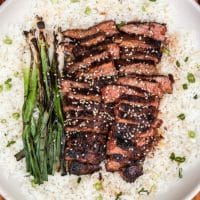Savor the fusion of East and West with this Teriyaki Steak meal prep, perfect for a flavor-packed, easy-to-assemble lunch option.
As I stood in my kitchen on a chilly winter evening, I found myself craving the warm, sweet and salty flavors of grilled teriyaki steak. This dish holds a special place in my heart, taking me back to childhood visits to my Japanese aunt’s house. I would sit at the kitchen table, mesmerized by the sizzling sounds and mouthwatering aromas as she prepared the meal.
With my aunt’s recent passing, making teriyaki steak fills me with nostalgia and a comforting connection to her. Though bittersweet, memories of her patiently teaching me to properly slice green onions and ginger flood my mind. I strive to recreate the dish as authentically as possible in her honor.
Tonight, I long for the simplicity and satisfaction teriyaki beef provides. As I gather ingredients, I already feel warmth and contentment washing over me. Soon my kitchen will smell of sweet soy sauce and seared beef, transporting me to happier times. With each bite, I hope to taste cherished memories that this humble recipe holds.
Teriyaki Steak meal prep


Steak Teriyaki
Ingredients
- 1 ½ pounds Olive oil flank or skirt steak
- Cooked rice for serving.
- steamed vegetables for serving.
Instructions
- Combine the ingredients for the marinade in a bowl and transfer it to a shallow container or resealable bag.

- Marinate the steak for one hour to overnight. Keep it chilled, and remove it from the refrigerator an hour before cooking.

- Drain off the marinade into a saucepan. Bring it to a boil.

- Reduce the heat and simmer until the marinade is reduced to a thin glaze (about 10 minutes).

- To grill, oil the grates and preheat the grill to high heat. Or heat up a large cast-iron pan over high heat. Pat the steaks dry and rub evenly with olive oil.

- Sear the meat on the grill or in the pan until one side is well browned (3-5 minutes). Flip over to sear the other side, while basting with the teriyaki marinade.

- After cooking the meat to the desired doneness, remove it from the heat. Let it rest for 10-15 minutes. Keep the sauce warm.

- After cooling, divide the steak by cutting it thinly along the grain. Slice each half diagonally, this time against the grain, in thin (¼ inch thick) slices. Arrange the slices on a serving plate. Pour the teriyaki sauce over the steak slices and serve over rice and steamed vegetables.

Video
Notes
Nutrition
© Food And Meal
This website provides approximate nutrition information for convenience and as a courtesy only. Nutrition data is gathered primarily from the Spoonacular Database, whenever available, or otherwise other online calculators.
Beef teriyaki bowl recipe

The art of marinating: our secret to flavor-packed steaks.To begin crafting this dish, one must consider the quality of the beef. Selecting a cut that is both flavorful and tender, such as sirloin or rib-eye, can truly elevate the eating experience. The beef should be sliced thinly against the grain, ensuring that each bite is easy to chew and full of flavor.
The teriyaki sauce is the heart of this dish, its composition a harmonious blend of soy sauce, mirin, sake, and sugar. These ingredients are simmered together until they form a glossy glaze. Adjusting the sweetness or saltiness to personal preference is an intimate process, as it allows the cook to impart their own touch to the dish.
As for the rice, using short-grain rice typically used in Japanese cooking is ideal for its sticky texture and ability to absorb the teriyaki sauce, making every spoonful a delightful combination of flavors and textures. Preparing the rice with care, ensuring it’s fluffy and well-seasoned, adds to the overall comfort this bowl provides.
Vegetables like broccoli, bell peppers, or carrots can be quickly sautéed and added to the bowl, not only for their nutritional value but also for their color and crunch, which gives a pleasing contrast to the tenderness of the beef.
When assembling the beef teriyaki bowl, I feel a sense of excitement and anticipation. Layering the warm rice, then the succulent beef, drizzling the sauce generously, and finishing with vegetables and perhaps a sprinkle of sesame seeds or a garnish of green onion, turns the simple act of plating into an artistic expression.
The first bite is always met with a moment of appreciation for the mingling flavors and the comforting warmth. There’s a certain joy in the simplicity of this dish, and yet, each component plays its part so perfectly that it feels like a celebration on the palate.
How to make teriyaki beef Stir Fry and broccoli
is beef teriyaki healthy ?
The primary components of beef teriyaki are beef and the teriyaki sauce. Beef is a rich source of protein and provides essential amino acids necessary for muscle growth and repair. It also contains important nutrients such as iron, zinc, and B vitamins. However, beef can be high in saturated fats, which, when consumed in excess, may contribute to an increased risk of heart disease. The cut of beef used in beef teriyaki can influence its overall healthiness; leaner cuts contain less fat and are generally healthier.
The teriyaki sauce, while imparting a delightful combination of sweetness and umami, can be high in sugars and sodium. These ingredients can have adverse health effects if consumed in large amounts, potentially leading to conditions such as obesity, hypertension, and other cardiovascular issues. Homemade teriyaki sauce can be tailored to reduce sugar and sodium levels, making it a healthier option compared to store-bought or restaurant versions.
Portion size is another factor in determining the healthiness of beef teriyaki. Consuming it in moderation within a balanced diet that includes a variety of vegetables and whole grains can make it part of a healthy meal. Conversely, large portions can lead to excessive calorie intake and potential weight gain.
Emotionally, beef teriyaki can offer a sense of satisfaction and pleasure due to its rich flavor profile, which can contribute positively to one’s overall dining experience. However, personal opinions on its healthiness may vary based on individual dietary goals, health concerns, and cultural values regarding food.
Expert Tips

Cooking notes about Steak Teriyaki recipes
First, I make sure to have all ingredients and equipment ready before starting. My aunt always stressed the importance of mise en place. As the steak marinates, aromas of soy sauce, honey, and ginger fill me with anticipation.
When cooking, I resist the urge to rush. Allowing the steak to properly sear enhances the sweet and savory glaze. Flipping too often leads to uneven color. I smile remembering my aunt’s mantra – “patience leads to the perfect crust.”
Finally, letting the steak rest allows juices to redistribute. I fight the temptation to immediately dig in! My aunt would gently yet firmly remind me, “good things come to those who wait.”
Serving Suggestions for grilled Teriyaki Steak

Teriyaki steak goes well with simple sides like steamed rice, sautéed vegetables, or a fresh green salad. For something heartier, try serving it with gyoza dumplings, miso soup, or yakisoba noodles. The sweet and salty flavors of the teriyaki sauce also pair nicely with wasabi, soy milk, egg salad, or tuna satay. For a fusion twist, serve the steak over rice with a side of kimchi stew or corn salsa. No matter what you choose, Steak Teriyaki makes for a delicious and versatile meal.
Top 9 FAQs about Teriyaki Steak meal prep

- What is teriyaki steak made of?
- Teriyaki beef is typically made with beef, marinated in a mixture of soy sauce, sake, mirin, and sugar, then grilled or pan-seared and glazed with a teriyaki sauce.
- How do you grill teriyaki steak without burning it?
- Avoid high heat initially, oil the grill grates, and monitor cooking time. Baste during cooking to prevent burning, and move to a cooler part of the grill if needed.
- How long should steaks be marinated?
- Marinate steaks for at least 1 hour to overnight. Longer marination enhances flavor, but 1 hour is sufficient for decent results.
- Does teriyaki sauce go on before or after cooking?
- Apply teriyaki sauce both during cooking (basting) and after. Basting adds flavor during cooking, and a post-cooking application adds a final glaze.
- Can I use other cuts of beef for Steak Teriyaki?
- Yes, you can. While ribeye and sirloin are popular, New York strip or filet mignon work too. Note that marbling contributes to tenderness and flavor.
- Is it necessary to marinate the steaks overnight?
- While overnight marination enhances flavor, marinating for at least 1 hour yields decent results. Longer marinating times intensify flavors.
- Can I make Steak Teriyaki indoors on a grill pan or stovetop?
- Absolutely. Use a grill pan or stovetop skillet for grill marks and cook indoors. Ensure the pan is hot and well-oiled for best results.
- How do I store leftover Steak Teriyaki?
- Store in an airtight container in the refrigerator. Consume within 3-4 days and reheat gently to prevent overcooking.
- Can I freeze Steak Teriyaki?
- Yes, freeze cooled slices in an airtight container or freezer bags. Use within 2-3 months for optimal quality.
Conclution
As I sit down to enjoy my Teriyaki Steak meal prep, the familiar flavors transport me back to my aunt’s kitchen. With each savory bite, memories of her patient guidance and our bonding over food preparation fill me with nostalgic warmth. Though I still miss her dearly, making this dish connects me to the joyful times we shared.
I’m thankful to have learned so much from my aunt, not only recipes but also deeper lessons on savoring life’s simple pleasures. By carrying on food traditions, I keep her spirit alive. As I continue perfecting my teriyaki steak, I hope to one day pass the recipe down just as she did – with patience, care and lots of love.
I'm James F Anderson, a noted sous chef from London and a Le Cordon Bleu alumnus. My career began in a Michelin-starred Parisian eatery, where my blend of classic and contemporary cooking, using seasonal ingredients, earned accolades. Recognized in culinary publications and on cooking shows, I’m committed to mentoring aspiring chefs and delivering memorable dining experiences, marking me as a standout talent in the culinary world.










